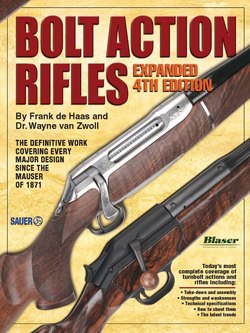Читать книгу Bolt Action Rifles - Wayne Zwoll - Страница 34
На сайте Литреса книга снята с продажи.
ОглавлениеTop view of the M71/84 Mauser action.
To disassemble the rest of the action, first turn out the cutoff spring screw and remove the cutoff spring. Lift out the cutoff. Turn out the carrier pin lock screw and lift out the carrier pin. Remove the carrier and carrier cam from the bottom of the action. Drive out the sear holder pin to remove the sear and trigger assembly. Reassemble in reverse order.
M71 and 71/84 Markings
Both the M71 and M71/84 Mauser rifles are easily identified by the stampings on the left side of the receiver. I G Mod. 71 is stamped on the 71 and I G Mod. 71/84 on the M71/84. The name of the manufacturer, such a Spandau, Amberg, et al, is usually stamped on the top flat of the breech end of the barrel on both models, along with a crown. The date (year) of manufacture is usually stamped on the right wall of the receiver bridge. Both models are serial numbered, with the numbers stamped on the receiver ring, breech end of the barrel and bolt, with the last two digits of that number stamped on most of the other parts.
Various German proofmarks are stamped on the barrel, receiver and bolt, as well as various inspector’s marks. A small number “11” stamped over the chamber indicates caliber 11mm.
Comments
The first Mauser rifle I ever owned was a Model 71/84, and with it came several boxes of fresh commercial ammunition. It was a carbine, in excellent condition, with a very nice light colored walnut stock. At that time I lived a long way from any boar hunting, but I often swung and snapped that rifle at a picture of a charging wild boar in my room. I fired that carbine a number of times at targets and enjoyed shooting it despite its heavy recoil. I don’t recall what became of it; I probably swapped it off for something more suited to my hunting needs.
Most likely many more M71s were made than were M71/84s, but both have been quite common in the U.S. since the turn of the century. After WWII a great many more were imported and sold; as late as 1967 one firm still offered M71/84s in very good condition for less than $15.
11 mm Mauser Cartridge
The 11.15x60R (.43”) Mauser cartridge, also designed by the Mauser brothers, was introduced with their M71 rifle in 1871. A rimmed and bottlenecked cartridge with a case 60mm long, for military use the standard original load was 77 grains of blackpowder behind a round-nosed lead bullet of 385 grains. Muzzle velocity was about 1440 fps. The standard military load for the M71/84 rifle had a flat-point bullet, otherwise it was identical.
The 11mm Mauser cartridge is practically the same as other 11mm military loads developed during the 1870s like the 43 Spanish, 11mm French Gras, 11mm Belgian Comblain and others. Like many cartridges developed for Mauser rifles, the 11mm Mauser became popular for sporting use in “as issued” M71 and M71/84 rifles and carbines, in remodeled military rifles, and in some sporting rifles specially chambered for it. Because of the many M71 and M71/84 Mauser rifles sold in the U.S. and Canada by Francis Bannerman & Son, both Remington and Winchester have loaded ammunition for it.
